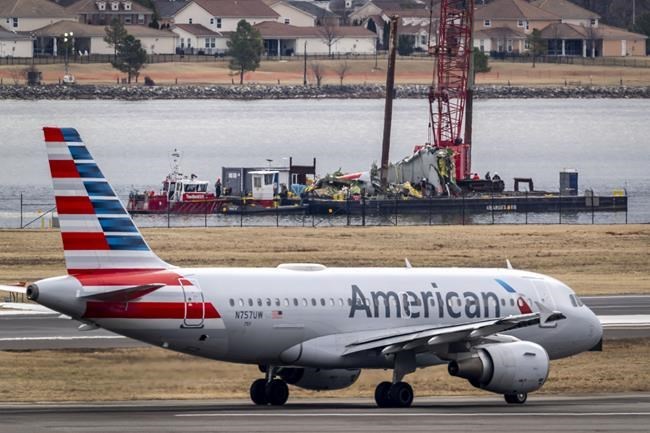
An aircraft prepares to take off on the runway as a salvage vessel carrying wreckage moves from the site in the Potomac River of a mid-air collision between an American Airlines jet and a Black Hawk helicopter, at Ronald Reagan Washington National Airport, Wednesday, Feb. 5, 2025, in Arlington, Va. (AP Photo/Ben Curtis)
Republished February 14, 2025 - 3:19 PM
Original Publication Date February 14, 2025 - 9:51 AM
On Jan. 29, an American Airlines passenger jet and an Army helicopter collided as the plane prepared to land at Washington D.C.’s Ronald Reagan National Airport. Both plunged into the Potomac River, killing all 67 people aboard.
On Friday, investigators said the helicopter may have had inaccurate altitude readings in the moments before the crash, and the crew may not have heard key instructions from air traffic controllers.
The collision was the deadliest plane crash in the U.S. since 2001, when a jet slammed into a New York City neighborhood just after takeoff, killing all 260 people on board and five more on the ground.
Air travel remains overwhelmingly safe in the U.S., but there have been a string of incidents in recent weeks, including a fiery explosion on Jan. 31 when a medical transport jet crashed into a Philadelphia neighborhood, killing seven people. Last week, a small commuter aircraft crashed off western Alaska, killing 10 people.
The crash
American Airlines Flight 5342 was coming in from Wichita, Kansas, carrying 60 passengers and four crew members, as it approached Reagan National to land on a clear Wednesday night. Nearby, a U.S. Army Black Hawk with three soldiers on board was on a training exercise, practicing emergency evacuation routes that would be used to ferry out key government officials in case of an attack or catastrophe.
A few minutes before the twin-engine jet was to land, air traffic controllers asked if it could use a shorter runway. The pilots agreed, and flight-tracking sites show the plane adjusted its approach.
Shortly before the collision, a controller got an alert that the plane and Black Hawk were converging and asked the helicopter if it had the plane in sight. The military pilot said yes and asked for “visual separation” with the jet — allowing it to fly closer than otherwise may have been allowed if the pilots didn’t see the plane. Controllers approved the request.
Roughly 20 seconds later, the aircraft collided.
The investigation
Since the crash, the National Transportation Safety Board has recovered all the flight data recorders and pulled the wreckage of both aircraft from the Potomac.
It will take more than a year to get the final NTSB report on the crash, but officials have been providing regular updates as investigators learn more and they plan to publish a preliminary report in the coming weeks.
NTSB Chairwoman Jennifer Homendy told reporters Friday that the Black Hawk's cockpit recorder suggested an incomplete radio transmission may have left the crew unable to hear air traffic control tell them, just before the crash, to move behind the jet.
“That transmission was interrupted -– it was stepped on,” she said, leaving the helicopter’s crew unable to hear the words “pass behind the” because their microphone key was pressed at the same moment.
The collision likely occurred at an altitude of about 325 feet, investigators have said, which would put the Black Hawk above its 200-foot limit for that location.
Cockpit conversations a few minutes before the crash indicated the crew may not have had accurate altitude readings, with the helicopter’s pilot calling out that they were then at 300 feet, but the instructor pilot saying it was 400 feet, Homendy said.
“We are looking at the possibility there may be bad data,” she said.
That generation of Black Hawks typically has two types of altimeters – one relying on barometric pressure and the other on radio frequency signals bounced off the ground. Helicopter pilots typically rely on barometric readings while flying, but the helicopter’s black box captures its radio altitude.
Almost immediately after the crash, President Donald Trump publicly faulted the helicopter, which had a flight ceiling of 200 feet (61 meters), for flying too high. He also blamed federal diversity and inclusion efforts, particularly regarding air traffic controllers. When pressed by reporters, the president could not back up those claims. A few days later, Trump placed the blame on what he called an “obsolete” air traffic control system.
Army officials have said the Black Hawk crew was highly experienced and familiar with the crowded skies around Washington.
The victims
The Army identified the Black Hawk crew as Capt. Rebecca M. Lobach of Durham, North Carolina; Staff Sgt. Ryan Austin O’Hara, 28, of Lilburn, Georgia; and Chief Warrant Officer 2 Andrew Loyd Eaves, 39, of Great Mills, Maryland. O’Hara was the crew chief and Eaves and Lobach were pilots.
Among the jet’s passengers were several members of the Skating Club of Boston returning from a development camp for elite junior skaters that followed the 2025 U.S. Figure Skating Championships in Wichita.
The victims also included a group of hunters returning from a guided trip in Kansas, four members of a steamfitters’ local union in suburban Maryland, nine students and parents from Fairfax County, Virginia, schools and two Chinese nationals.
News from © The Associated Press, 2025